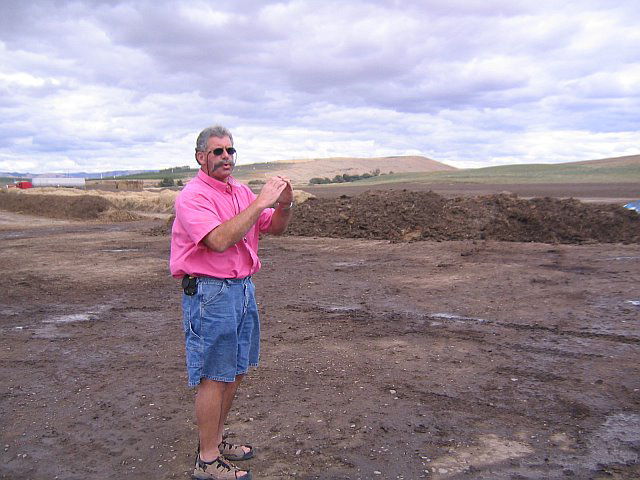Dr Vino's wine blog
wine talk that goes down easy
First person: Rick Trumbull
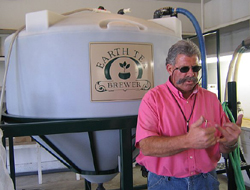 Rick Trumbull is an engaging character. He used to sell chemicals to farmers. Then he had a conversion to sustainability and organics. Now he makes compost for vineyards in the Walla Walla Valley such as Seven Hills vineyard.
Rick Trumbull is an engaging character. He used to sell chemicals to farmers. Then he had a conversion to sustainability and organics. Now he makes compost for vineyards in the Walla Walla Valley such as Seven Hills vineyard.
I visited his compost facility in Walla Walla recently. I recorded a few minutes of Rick talking about making his compost. Get the poop and listen to the audio!
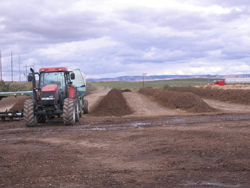
I also put up a photo of Rick in front of his “compost tea” brewer. Rick essentially steeps some compost in water, which then forms a nutritionally rich solution that can be applied to the vineyard. I never knew dirt could be so interesting.
Download audio 3mins 49secs, .wma format.
(Sorry about the wind–I’m new to audio. Hopefully podcaster Tim will be able to provide technical advice.)
 tags: wine | sustainable agriculture | compost | walla walla
tags: wine | sustainable agriculture | compost | walla walla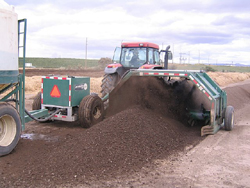
Michel Rolland, the man, the myth, the legend: part deux
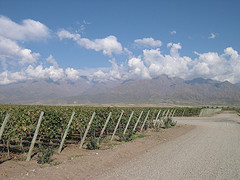 [For part I of this story click here.]
[For part I of this story click here.]
The wines included three vintages from Clos de los Siete in Argentina and four Dourthe properties from Bordeaux.
As with many Argentine wines, the Clos de los Siete packs a lot of punch for a $15 red. Mostly malbec, Rolland blends in healthy doses of cabernet sauvignon and merlot as well as a dollop of syrah, something he couldn’t do in Bordeaux. These are big wines, not for the faint of heart.
The first commercial vintage of 2003 I found to be an abrupt combination of dark fruits and alcohol. (find this wine) The 2004 I found more balanced between the fruit and the alcohol—it’s elegant in the way that a woman on a Harley Davidson is elegant. (find this wine) The 2005, Rolland assured us, would be the best wine of the three but at this point I was surprised by its monochromatic heft that made me want to sing “oh tannin-bomb.†He said that it would settle down quickly since it was just bottled 2 months ago. (find this wine)
The 2003 Bordeaux wines were stylistically different and varied. The Ch Pey de la Tour has a rich style but had a light minerality that the Argentines lacked. (find this wine) The Le Bosq is a serious wine with notes of leather, dark fruit, beef drippings and vanilla. It made me say “mmm, Bordeaux.†(find this wine) The Ch La Garde is made in a lighter style that was oddly vegetal given the high heat of the vintage. (find this wine) The Ch Belgrave was solid though lacked the depth of the Le Bosq. (find Belgrave 2003)
Do you use American oak, came a question from the crowd?
“No, it’s very peculiar. I don’t like the taste.†Rolland replied. “But that said, maybe we will look at it again soon since it is economically interesting.â€
Huh? I did not understand this sudden flash of economic rationality for the aesthete winemaker with the high fees. That’s like saying you don’t like McRibs but you’ll eat them because they’re $0.99.
So, returning to the Mondovino criticism, does he have a one size fits all solution? The answer appears to be variation within a range. He seems to implement many of the same practices in the vineyard—thinning leaves, reducing yields, and picking late—wherever he goes. He was adamant that while some Argentines are trying to improve their wines with the use of small oak barrels but they had not done enough to lower their yields.
And he no doubt has many similar practices in the winery, though he was less forthcoming about those. But the wines I tasted were different across regions and across vintages.
He is clearly a man of strong views, moderated by a sense of humor, and a love of Argentina. He loves the free reign that his investors have given him in Clos de los Siete and he loves the freedom that Argentina gives him to plant however and whatever he wants. “I am a blender—I love to blend.†He’s mixing it up in the wine world.
* * *
The following day, Rolland appeared on the Leonard Lopate Show on WNYC. Listen here.
See my photos from Argentina, including Clos de los Siete.
Related: “Malbec match-up” [Dr. V]
 tags: wine | Michel Rolland | Clos de los Siete
tags: wine | Michel Rolland | Clos de los Siete
Meeting Michel Rolland
Michel Rolland, the globetrotting consulting enologist, is perhaps best known for playing the role of Mephistopheles himself in the documentary Mondovino. He was shown cackling in the back seat of his limousine smoking cigarillos and urging various winery owners in Bordeaux to “mico-oxygenate.†The film portrayed him as on par with Robert Parker, the Emperor of Standardization and Globalization (read my review of Mondovino here).
So I was surprised to see a different Michel Rolland lead members of the NYC press and trade in a tasting yesterday of seven wines that he had made. Although he wore suit that made him look more like he hangs out at investment banks rather than fermentation tanks, he was charming. He joked and told stories. This was the human face of globalization? He didn’t strike me as particularly fearsome.
Rolland is known as the “flying winemaker†par excellence. He consults to over 100 wineries mostly in Bordeaux where he got his start on the right bank. He wryly observed, “I started making wine in the US before I went to the [left bank] Medoc!†Along with 14 wineries in California, he consults in countries as diverse as India, Tunisia, and Uruguay, which makes him a juicy target for his detractors. His wines are often big and powerful since he likes to pick his grapes late and use French oak barrels. His fees are as high as his Parker point scores.
He said there are three keys to making great wine: great terroir, great grapes, and picking at the right time. Hmm, great wine is made in the vineyard? Sounds as if he might be talking himself out of a job as winemaker.
To illustrate the point that winemaking now requires more attention in the vineyard re recalled his first harvest in California in 1986. As the grapes were coming into the crushpad, a priest was there to bless them. He asked Zelma Long where the grapes had come from. She didn’t know.
Now, it’s all about the vineyard. And he sure has a big one in Argentina with five investors from Bordeaux in Clos de los Siete. (The d’Aulan family, the seventh in the name of the project, withdrew to focus their efforts on their Alta Vista winery) They just started planting in 1999 and quickly covered 450 hectares in vines. Then they stopped. The scary part is they still have 200+ more hectares that they can plant. With a vine density of 5,550 per hectare, that’s 2.5 million vines growing. That’s mucho malbec.
He said that contrary to his portrayal in Mondovino, he does not advise everyone to microxygenate, a process of running small bubbles through the wine during fermentation to soften the tannins. This is particularly the case in Argentina where they have such phenolic maturity that adding oxygen would turn the wines an unpleasant brown.
“The whole argument about globalization and standardization is silly,†he told me after the tasting. He said he doesn’t make wine one according to a formula. “You could taste that here today!â€
But could I? Stay tuned tomorrow for part deux, including tasting notes, his thoughts on American oak and more.
Continue- “Michel Rolland: the man, the myth, the legend, part deux“
SPF or ABV?
What’s more important for consumers: the wine’s alcohol level or the SPF number in sunscreen for grapes?
Well, it’s not quite that bad. But the AP reports that one Napa winemaker is applying a “suncreen” to his grapes. Aaron Pott at Quintessa, who uses the organic plus plus method of vineyard management known as biodynamics, applies a “tea” to the grapes to prevent them from withering in the sun. The dilute tea includes algae to absorb UV rays and aloe vera for soothing. He says it will have washed off by the time the grapes are harvested.
Pott may put on the sunscreen, but does he give the grapes back rubs too?
Bad Boy, the table wine
Jean-Luc Thunevin is a “bad boy.” So says Robert Parker. The maker of the vin de garage Valandraud may have turned heads thus far in his brief career as a vintner but now he’s turning tables–table wine, that is.
This vintage will be the first vintage of “Bad Boy,” the table wine, produced by Thunevin. Making a quality wine in the administrative category vin de table is a rarity in France.
“The appellation system is still very important for the French consumer,” Jean-Luc Thunevin told me recently. But he is willing to forego it for this wine in order to radically experiment with this wine.
Bad Boy will be a blend of 70-30 blend of merlot and grenache. The grapes for this unusual blend will come from St. Emilion and Thunevin’s property in the Roussillon, respectively. Michel Rolland will be the consulting enologist. “He’s the best blender,” Thunevin told me. The wine has not yet been priced.
The wine will have a picture of a black sheep on the label and Bad Boy in large font.
Vin de table is rare in France since restrictions prohibit producers from stating either the region or even the vintage on the label.
Related: “Merlot-grenache” [Dr. V]
 tags: wine | French wine | AOC | Thunevin
tags: wine | French wine | AOC | Thunevin
Merlot-grenache
I spoke with a cult producer last week who told me that he will release a new wine this fall: a blend of merlot and grenache. Unusual, eh? But thinking about it, the smooth of merlot blended with the sweet of grenache and I’m surprised there isn’t more of this already.
More details in the new wine to follow. But in the meantime, which two regions will the grapes come from? Post your guess in the comments below. The winner will get a link back to his or her blog/site or, if blogless, some form of glorious mention here that trumpets their wine savvy.
UPDATE 9/7: Thanks to all for guessing in the comments and to Whit for guessing the hardest. The answer lies here with Jean-Luc Thunevin of Valandraud.
 tags: wine | wine blends
tags: wine | wine blends
Grapes on the half shell
Which wine goes with oysters? A crisp sauvignon blanc is likely to be your reply. Yesterday, I had merlot and oysters.
Not that I ate oysters and drank the merlot mind you. But they were together.
I attended a seminar with Steve Smith, vineyard manager, winemaker, partner and all-around grape guru at Craggy Range. Founded in 2001 in the cool Gimblett Gravels area (Hawke’s Bay) of New Zealand, Craggy Range also makes single vineyard wines from Otago and Martinborough.
I tried two barrel samples of merlot from Gimblett Gravels. One was more plush, more merlot-like. The other was tightly wound and high in acidity–not bad for a barrel sample. Were they from different vineyards? In fact, no, they were even from the same block of the same vineyard.
To explain the difference, Steve had me shine a flashlight on a gray rock from the vineyard. Pretty dull. Then he sprinkled some crushed oyster shells on it and had me shine the flashlight on it again. The reflection was brighter.
Steve had done the same thing in the vineyard. He had sprinkled half of the vineyard block with crushed oyster shells, which then reflected some sun light onto the grapes and leaves that were normally obscured. The barrel sample made from the oyster side of the vineyard was the one that was more plush and had greater depth.
Grapes grown on the half shell? It could be the wave of the future.
www.cragyrange.com
* * * * *
Craggy Range, “Sophia” 2004. Find this wine
This blend of merlot and cabernet franc has a rich, dark color with aromas of blueberry and cigar box. The firm tannins give it a good structure for aging and a good finish. I’d love to taste it next to some blended wines of the same grapes from Bordeaux and Long Island to tell the effects of terroir–oysters or not.
 tags: wine | vineyards | Craggy Range | oysters
tags: wine | vineyards | Craggy Range | oysters
Vino Diesel

Silly me. I called the phenomenon of French winemakers who are forced to distill their surplus wine into ethanol, a fuel additive, “vin diesel.” But the real vin diesel has just stood up.
The fashionistas who run Diesel jeans know how to charge since their denim can cost $150 or more. They have taken this ability to wine and rolled out two red wines and a Chardonnay that fetch $190 in wine shops in London and almost $300 in restaurants accoding to Decanter. The wines are not available yet in the US. (check availability)
Actually, vino diesel would be more apt since Renzo Rosso, founder of the Diesel brand, has hired enologist Roberto Cipresso to make the wines for him from a 12 acre vineyard on his farm in Veneto. “For successful living,” runs their tag line. Indeed.
